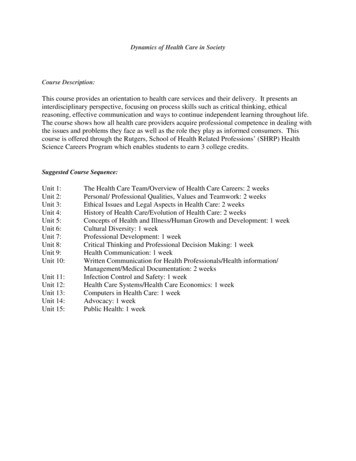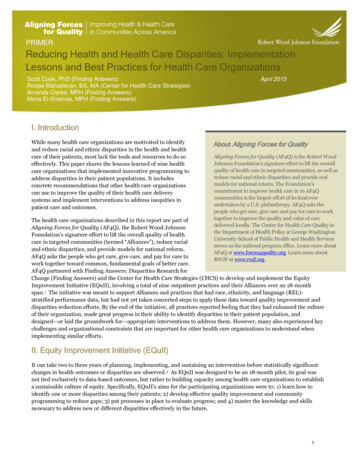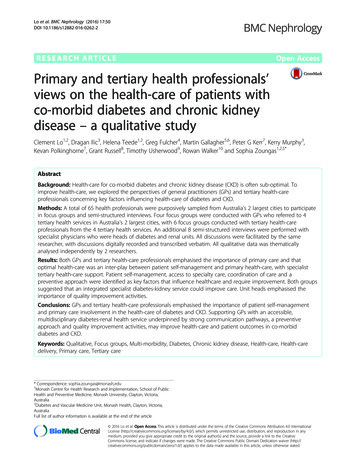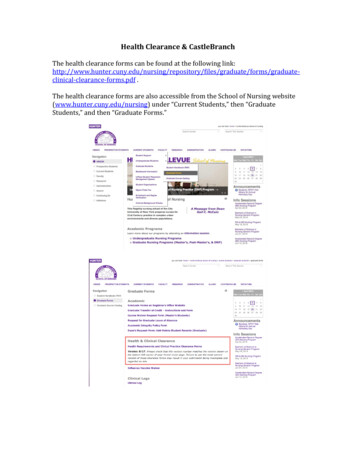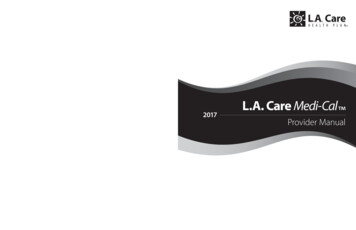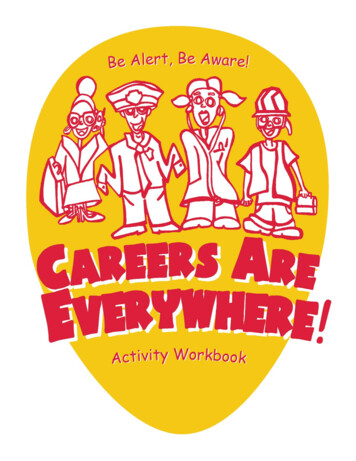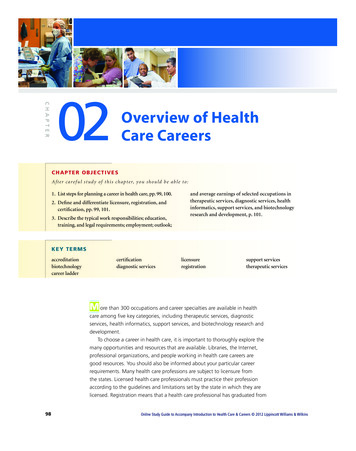
Transcription
C H A PTER02Overview of HealthCare CareersCHAPTER OBJECTIVESAf t e r c a re f u l s t u dy of t h i s c h a p ter, you should be able to:1. List steps for planning a career in health care, pp. 99, 100.2. Define and differentiate licensure, registration, andcertification, pp. 99, 101.3. Describe the typical work responsibilities; education,training, and legal requirements; employment; outlook;and average earnings of selected occupations intherapeutic services, diagnostic services, healthinformatics, support services, and biotechnologyresearch and development, p. 101.KEY TERMSaccreditationbiotechnologycareer laddercertificationdiagnostic serviceslicensureregistrationsupport servicestherapeutic servicesM ore than 300 occupations and career specialties are available in healthcare among five key categories, including therapeutic services, diagnosticservices, health informatics, support services, and biotechnology research anddevelopment.To choose a career in health care, it is important to thoroughly explore themany opportunities and resources that are available. Libraries, the Internet,professional organizations, and people working in health care careers aregood resources. You should also be informed about your particular careerrequirements. Many health care professions are subject to licensure fromthe states. Licensed health care professionals must practice their professionaccording to the guidelines and limitations set by the state in which they arelicensed. Registration means that a health care professional has graduated from98LWBK951 ch17-p97-103.indd 98Online Study Guide to Accompany Introduction to Health Care & Careers 2012 Lippincott Williams & Wilkins6/12/11 10:58 AM
C H A P T E R 17O v e r v i e w o f H e al t h Care Careers99an accredited school and has passed a standardized national exam administeredby a nongovernmental agency, usually a professional organization. Certification,which is awarded by professional organizations, is generally optional but oftenleads to more and better job opportunities and higher pay.Because health care has developed into a multibillion-dollar industry andis the largest occupational field in the United States, a health care career is anexcellent one to pursue.BUILD YOUR UNDERSTANDINGObjectives 1 and 2: List steps for planning a career in healthcare, and define and differentiate licensure, registration,and certification.CrosswordComplete this crossword puzzle using clues across and down to familiarize yourself with the terminologyof health care careers.Online Study Guide to Accompany Introduction to Health Care & Careers 2012 Lippincott Williams & WilkinsLWBK951 ch17-p97-103.indd 996/12/11 10:58 AM
1 0 0 PART I VC AR E E R PR OF IL E SAcross1. Recognition by an outside agency, such as anational board or commission, that a school hasstandards that qualify graduates for professionalpractice3. Granted when the requirements set by a certifying organization to demonstrate mastery ofthe job are metDown2. Field in which health care professionals determine the presence, absence, or extent of diseaseand provide data on the effectiveness of treatment (2 words)5. Hierarchy of careers in a given field (2 words)4. Career cluster involve managing medicalinformation, using computers and other meansto document client care or provide medicalinformation to health care professionals, insurers, patients, and the public (2 words)6. Graduation from an accredited school andhaving passed a standardized national examadministered by a nongovernmental agency7. Manipulation of genetic material in livingorganisms, or parts of living organisms, to makeproducts and services8. Field in which health care workers providecare for patients, directly or indirectly, or theycreate a therapeutic environment for providingcare (2 words)9. Authority granted by state governments forindividuals to work in a certain health careprofession in a particular state10. Health care field in which treatment is provided for patients or animals to maintain orimprove their health over time (2 words)Objective 1: List steps for planning a career in health care.JumbleAfter answering the questions below about planning a career in health care, use the circled letters to formthe answer to this jumble (punctuation [e.g., hyphens, apostrophes, etc.] counts as a character).Clue: When the future health care worker was trying to decide what specific career to pursue, she did whatto follow in her mentor’s footsteps? “ - ”1. When thinking about a career in health care, it is important to explorethe manyopportunities and resources available.2.offer books that give a broad overview of many occupations; books written by nurses,paramedics, and other professionals about their experiences at work; databases; lists of Web sites; andother references on health care careers.3. Published by the U.S. Bureau of Labor Statistics, the OccupationalHandbook provides jobdescriptions, prospects, earnings, requirements, etc. to prospective employees.Online Study Guide to Accompany Introduction to Health Care & Careers 2012 Lippincott Williams & WilkinsLWBK951 ch17-p97-103.indd 1006/12/11 10:58 AM
C H A P T E R 17O v e r v i e w o f H e al t h Care Careers1014. On the Internet, you can find almost any information about health care occupations, including schoolsthat offer programs of study to prepare for the career,interviews with workers in the occupa-tion, and a wealth of other useful information.5. Professional organizations represent most health care specialties, and both visiting theirand contacting a local chapter are good ways of gaining information.6. Spending a day on the, and talking to people who work in that occupation, is often the best wayto determine whether an occupation is right for you.Objective 2: Define and differentiate licensure, registration, andcertification.Short AnswerAfter reading the section, “Educational Requirements” in Chapter 17, answer the following questions andbe as specific as you can.1. Define the following terms and provide example(s) of each.a. Licensureb. Registrationc. Certification2. Explain the key differences among the above three terms.Objective 3: Describe the typical work responsibilities; education,training, and legal requirements; employment; outlook; andaverage earnings of selected occupations in therapeutic services,diagnostic services, health informatics, support services, andbiotechnology research and development.True or False?After reviewing the section, “Health Care Careers,” read the statements below and circle T if they are trueor F if they are false.1.TFTherapeutic services (providing treatment for patients or animals) jobs include physicians,physician assistants, medical assistants, surgical technologists, physical therapists, physicaltherapist assistants, occupational therapists, occupational therapist assistants, orthotists/prosthetists, respiratory therapists, paramedics, emergency medical technicians, registered nurses, licensed practical nurses, nursing assistants, home health aides, audiologists,audiometric technicians, speech-language pathologists, speech-language pathology assistants, ophthalmologists, optometrists, ophthalmic medical technicians, athletic trainers,pharmacists, pharmacy technicians, dentists, dental hygienists, dental assistants, dental labtechnicians, chiropractors, massage therapists, dieticians, dietetic technicians, psychologists, social workers, veterinarians, and veterinary technicians, among others.Online Study Guide to Accompany Introduction to Health Care & Careers 2012 Lippincott Williams & WilkinsLWBK951 ch17-p97-103.indd 1016/12/11 10:58 AM
1 0 2 PART I VC AR E E R PR OF IL E S2.TFPhysician assistants provide primary care in places where physicians are sometimes inshort supply and also free up busy physicians by assuming responsibility for routinetasks.3.TFPracticing as a physician assistant requires a driver’s license, at least 4 years of college,and recertification every year.4.TFPhysician assisting is not a popular field and is expected to grow by only 3.9 percentby 2018.5.TFAlthough salaries vary depending on specialty, location, and experience, the medianannual salary for physician assistants was 81,230 as of May 2008.6.TFThe basic difference between a technician and a technologist is education. Generally,technicians hold an associate’s degree, whereas technologists have a bachelor’s degree.7.TFProfessionals in diagnostic services careers determine the presence, absence, orextent of disease and provide data on the effectiveness of treatment and include cardiovascular technologists, cardiographic technicians, electroneurodiagnostic technologists, clinical laboratory technologists, clinical laboratory technicians, laboratoryassistants, pathologists, pathologist assistants, phlebotomists, radiologists, radiologictechnologists/radiographers, computed tomography technologists, magnetic resonance technologists, diagnostic medical sonographers, positron emission tomography technologists, and nuclear medicine technologists, among others.8.TFFor diagnostic scanning, the nuclear medicine technologist prepares and administersradioactive material, which is attracted to a particular part of the body and concentratesthere for a brief time; the technologist then looks for lower or higher concentrations ofthe material than expected, which can indicate disease, and selects images to show thephysician as well as doing some preliminary analysis.9.TFCertificate programs for nuclear medicine are intended for health care professionals whodo not want an associate’s or bachelor’s degree but wish to specialize in nuclear medicine.10.TFIt is projected that this occupation will add 36,000 jobs from 2008 to 2018, and thattechnologists who specialize in a particular type of diagnostic scans will have the bestjob prospects.11.TFThe median annual salary of nuclear medicine technologists in 2008 was 66,660.12.TFCareers in the health informatics career cluster involve managing medical information and include health services administrators, medical librarians, health educators,health information coders, medical billers, health information technicians, and medical transcriptionists, among others.13.TFMedical transcriptionists listen to recordings dictated by physicians and other healthcare professionals and transcribe them into medical reports, letters, and other documents, so for this occupation, accuracy, attention to detail, and knowledge of medicalterms, jargon, and abbreviations are essential.14.TFTo be a medical transcriptionist, certification is required by the Association forHealthcare Documentation Integrity.15.TFJob opportunities are not looking good for medical transcriptionists, who earn, onaverage, 15,410 annually.16.TFSupport services professionals provide direct or indirect care for patients or create atherapeutic environment for providing health care and include biomedical engineers,biomedical/clinical technicians, and industrial hygienists, among others.Online Study Guide to Accompany Introduction to Health Care & Careers 2012 Lippincott Williams & WilkinsLWBK951 ch17-p97-103.indd 1026/12/11 10:58 AM
C H A P T E R 17O v e r v i e w o f H e al t h Care Careers10317.TFBiomedical engineers create devices and procedures that improve health care bysolving medical and health-related problems and have at least a bachelor’s degree,although a graduate degree is often preferred or required.18.TFBiomedical engineering is the slowest-growing occupation in the United States, andit pays about 17.40 an hour.19.TFBiotechnology research and development careers involve the manipulation of geneticmaterial in living organisms to make products and services and include microbiologists, medical scientists, research scientists, and research assistants, among others.20.TFTo become a research assistant (involving managing instruments, monitoring experiments, analyzing data, interpreting results, and preparing technical reports and plansfor experiments or studies), a person needs an associate’s degree in applied sciencefrom a community college or technical school.EXPAND YOUR KNOWLEDGEEssay QuestionFrom Investigate It activity number 2 in your textbook, write a brief essay describing in detail the healthcare occupation you chose to profile.Online Study Guide to Accompany Introduction to Health Care & Careers 2012 Lippincott Williams & WilkinsLWBK951 ch17-p97-103.indd 1036/12/11 10:58 AM
CHAPTER 17 Overview of Health Care Careers 99 . other references on health care careers. 3. Published by the U.S. Bureau of Labor Statistics, the Occupational _ _ _ _ _ Handbook provides job descriptions, prospects, earnings, requirements, etc. to prospective employees.

